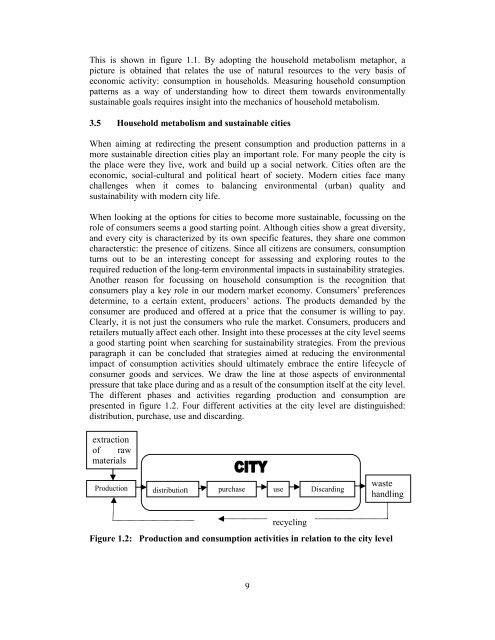Household Metabolism in the Five Cities.
Household Metabolism in the Five Cities.
Household Metabolism in the Five Cities.
You also want an ePaper? Increase the reach of your titles
YUMPU automatically turns print PDFs into web optimized ePapers that Google loves.
This is shown <strong>in</strong> figure 1.1. By adopt<strong>in</strong>g <strong>the</strong> household metabolism metaphor, a<br />
picture is obta<strong>in</strong>ed that relates <strong>the</strong> use of natural resources to <strong>the</strong> very basis of<br />
economic activity: consumption <strong>in</strong> households. Measur<strong>in</strong>g household consumption<br />
patterns as a way of understand<strong>in</strong>g how to direct <strong>the</strong>m towards environmentally<br />
susta<strong>in</strong>able goals requires <strong>in</strong>sight <strong>in</strong>to <strong>the</strong> mechanics of household metabolism.<br />
3.5 <strong>Household</strong> metabolism and susta<strong>in</strong>able cities<br />
When aim<strong>in</strong>g at redirect<strong>in</strong>g <strong>the</strong> present consumption and production patterns <strong>in</strong> a<br />
more susta<strong>in</strong>able direction cities play an important role. For many people <strong>the</strong> city is<br />
<strong>the</strong> place were <strong>the</strong>y live, work and build up a social network. <strong>Cities</strong> often are <strong>the</strong><br />
economic, social-cultural and political heart of society. Modern cities face many<br />
challenges when it comes to balanc<strong>in</strong>g environmental (urban) quality and<br />
susta<strong>in</strong>ability with modern city life.<br />
When look<strong>in</strong>g at <strong>the</strong> options for cities to become more susta<strong>in</strong>able, focuss<strong>in</strong>g on <strong>the</strong><br />
role of consumers seems a good start<strong>in</strong>g po<strong>in</strong>t. Although cities show a great diversity,<br />
and every city is characterized by its own specific features, <strong>the</strong>y share one common<br />
characterstic: <strong>the</strong> presence of citizens. S<strong>in</strong>ce all citizens are consumers, consumption<br />
turns out to be an <strong>in</strong>terest<strong>in</strong>g concept for assess<strong>in</strong>g and explor<strong>in</strong>g routes to <strong>the</strong><br />
required reduction of <strong>the</strong> long-term environmental impacts <strong>in</strong> susta<strong>in</strong>ability strategies.<br />
Ano<strong>the</strong>r reason for focuss<strong>in</strong>g on household consumption is <strong>the</strong> recognition that<br />
consumers play a key role <strong>in</strong> our modern market economy. Consumers’ preferences<br />
determ<strong>in</strong>e, to a certa<strong>in</strong> extent, producers’ actions. The products demanded by <strong>the</strong><br />
consumer are produced and offered at a price that <strong>the</strong> consumer is will<strong>in</strong>g to pay.<br />
Clearly, it is not just <strong>the</strong> consumers who rule <strong>the</strong> market. Consumers, producers and<br />
retailers mutually affect each o<strong>the</strong>r. Insight <strong>in</strong>to <strong>the</strong>se processes at <strong>the</strong> city level seems<br />
a good start<strong>in</strong>g po<strong>in</strong>t when search<strong>in</strong>g for susta<strong>in</strong>ability strategies. From <strong>the</strong> previous<br />
paragraph it can be concluded that strategies aimed at reduc<strong>in</strong>g <strong>the</strong> environmental<br />
impact of consumption activities should ultimately embrace <strong>the</strong> entire lifecycle of<br />
consumer goods and services. We draw <strong>the</strong> l<strong>in</strong>e at those aspects of environmental<br />
pressure that take place dur<strong>in</strong>g and as a result of <strong>the</strong> consumption itself at <strong>the</strong> city level.<br />
The different phases and activities regard<strong>in</strong>g production and consumption are<br />
presented <strong>in</strong> figure 1.2. Four different activities at <strong>the</strong> city level are dist<strong>in</strong>guished:<br />
distribution, purchase, use and discard<strong>in</strong>g.<br />
extraction<br />
of raw<br />
materials<br />
Production distribution purchase use Discard<strong>in</strong>g<br />
waste<br />
handl<strong>in</strong>g<br />
recycl<strong>in</strong>g<br />
Figure 1.2: Production and consumption activities <strong>in</strong> relation to <strong>the</strong> city level<br />
9
















